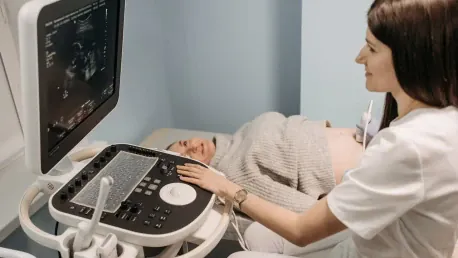The advent of artificial intelligence (AI) in the medical field has long promised revolutionary changes, but one of its latest applications, known as PlacentaVision, may truly transform neonatal and maternal healthcare. Developed by researchers from Northwestern Medicine and Penn State, this groundbreaking tool leverages advanced computer vision and AI to enable rapid, accurate placental examinations immediately after birth. By providing critical diagnostic insights in a timely manner, PlacentaVision has the potential to significantly enhance patient outcomes, offering a new level of care that was previously unattainable.
PlacentaVision functions as a sophisticated computer program designed to analyze photographs of placentas taken right at birth. Through this analysis, it can detect abnormalities that may indicate infections or neonatal sepsis, a severe and potentially life-threatening condition that affects millions of newborns every year. According to Dr. Jeffery Goldstein, the study’s co-author and the director of perinatal pathology at Northwestern University Feinberg School of Medicine, the capability to diagnose issues swiftly using photographs can drastically reduce the time required for diagnosis, which is essential for faster medical decision-making and improved patient care.
The Development and Significance of PlacentaVision
PlacentaVision’s foundation lies in extensive research and development, with considerable input from Northwestern, which provided the largest set of images for the study. Dr. Goldstein played a pivotal role in developing and debugging the algorithms that drive the tool. The idea for this innovative technology originated from Alison D. Gernand, an associate professor at Penn State and the project’s principal investigator. Gernand’s work in global health emphasized the need for a tool like PlacentaVision, especially in low-resource settings where women frequently give birth at home due to a lack of sufficient healthcare services.
One prevalent issue worldwide is that placentas are often discarded without proper examination, which Gernand identifies as a missed opportunity to gather valuable diagnostic information. Examining the placenta can uncover crucial details about potential complications, facilitating early intervention that can greatly improve health outcomes for both mother and child. In Gernand’s view, utilizing PlacentaVision to perform these examinations could transform the approach to maternal and neonatal care, especially in regions where healthcare resources are limited.
Importance of Swift Diagnosis and Diverse Applicability
The speed of diagnosis is crucial when it comes to placental examinations, and PlacentaVision targets this critical need. Swift diagnosis can lead to prompt interventions that potentially save lives. PlacentaVision’s applicability across diverse medical environments further underscores its value. Whether in well-equipped urban hospitals or under-resourced rural areas, the tool promises to enhance medical diagnostics universally. The early examination of the placenta is fundamental to the health of both the pregnant individual and the baby during pregnancy, yet this practice is often neglected, particularly in low-resource settings.
PlacentaVision employs an advanced AI technique known as cross-modal contrastive learning. This method aligns and interprets relationships between different data types, including visual images and textual pathological reports. During its development, the research team accumulated an extensive and varied dataset of placental images and pathological reports collected over twelve years. The images were meticulously analyzed for health outcomes, and this data informed the creation of a model capable of predicting health risks based on new images. By simulating a range of photo-taking conditions, the researchers ensured the tool’s resilience and robustness, making it adaptable to different environments and conditions.
PlacentaCLIP+ and Its Practical Applications
The end product, PlacentaCLIP+, stands out as a precise machine-learning model validated across various populations to ensure consistent performance globally. PlacentaVision is designed to be user-friendly and can potentially be accessed via a smartphone app or integrated into medical record software, providing prompt and actionable insights to healthcare practitioners. This ease of use is pivotal in promoting wide adoption and ensuring that the benefits of early diagnosis are realized quickly and efficiently.
Yimu Pan, the study’s lead author and a doctoral candidate in the informatics program at Penn State, underscores the significant advantages of making placental examinations more accessible. Such accessibility could markedly improve future pregnancies, particularly for mothers and infants at a higher risk of complications. The timely identification of infections using PlacentaVision can trigger immediate medical responses, including administering antibiotics or closely monitoring newborns for signs of infection, thus preventing more severe health issues before they can escalate.
Versatility and Future Enhancements
One of PlacentaVision’s greatest strengths is its versatility. In settings with limited resources, the tool can enable healthcare providers to identify potential infections rapidly. In more advanced medical facilities, it can assist in prioritizing which placentas require detailed examination. Dr. James Z. Wang, a distinguished professor at Penn State and a principal investigator on the study, highlights the challenge of ensuring the model’s flexibility to handle various placental diagnoses. The tool also needed to maintain robust performance under different conditions, including variations in lighting, imaging quality, and clinical settings.
Looking ahead, researchers plan to refine PlacentaVision to enhance its usability and effectiveness further. One of the primary goals is to develop a user-friendly mobile application for medical professionals that requires minimal training and can be used in a variety of clinical settings. This app would allow healthcare providers to photograph placentas and receive instant feedback, thereby significantly improving neonatal and maternal care across the board.
The research team also aims to make PlacentaVision smarter by incorporating additional types of placental features and clinical data, which will bolster its predictive capabilities. Testing the tool across different hospitals is another crucial step to ensure its applicability in various settings and to fine-tune its functionality based on real-world use cases.
Potential Impact on Global Healthcare
The advent of artificial intelligence (AI) in medicine has long promised revolutionary changes, and one of its latest applications, PlacentaVision, could truly transform neonatal and maternal healthcare. Developed by researchers from Northwestern Medicine and Penn State, this innovative tool uses advanced computer vision and AI to enable rapid, accurate placental examinations immediately after birth. By providing critical diagnostic insights swiftly, PlacentaVision has the potential to significantly improve patient outcomes, offering a level of care previously unattainable.
PlacentaVision operates as an advanced computer program designed to analyze photos of placentas taken right at birth. This analysis can detect abnormalities that might indicate infections or neonatal sepsis, a severe, potentially life-threatening condition affecting millions of newborns annually. According to Dr. Jeffery Goldstein, the study’s co-author and director of perinatal pathology at Northwestern University Feinberg School of Medicine, the ability to diagnose issues quickly using photos can drastically reduce the time needed for diagnosis, essential for faster medical decisions and better patient care.









